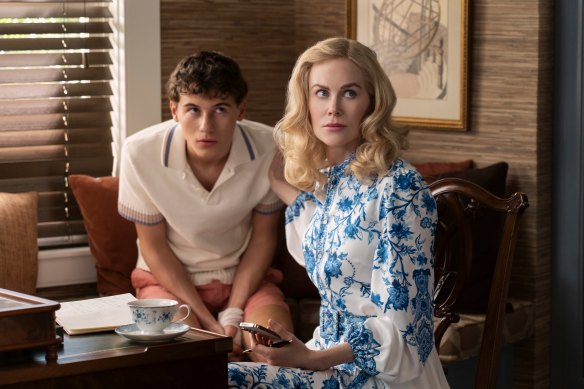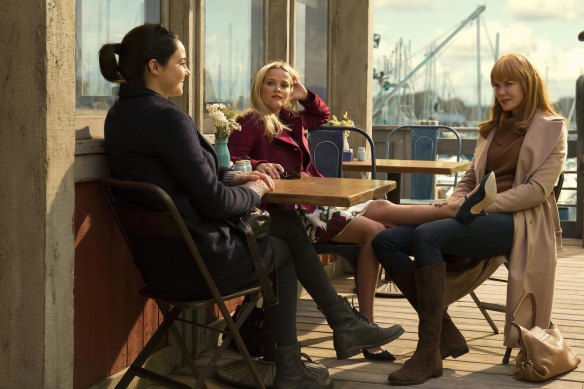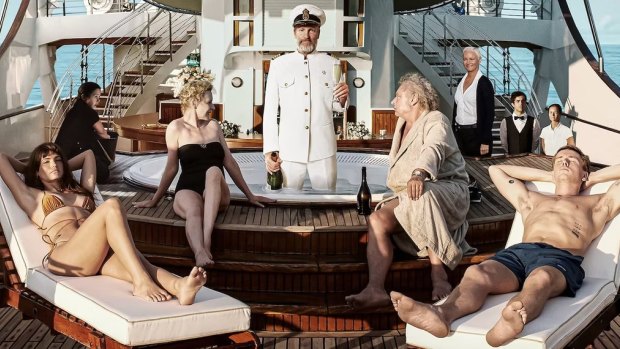Rich, white and dead: Has TV’s favourite formula gone stale?
Midway through the first episode of The Perfect Couple, the shiny new Netflix series about a wealthy Nantucket family whose picture-perfect life is derailed by a shocking murder, there is a moment that, perhaps unintentionally, epitomises the dominant TV trend of our time.
Abby Winbury (Dakota Fanning), a well-to-do high society type, is being interviewed by police following the discovery of a body on a property owned by her mother-in-law, famous novelist Greer Garrison Winbury (Nicole Kidman).
The authorities are curious: could the matriarch of Nantucket’s most respected blue-blood clan be capable of murder? “They’re rich,” deadpans Abby by way of explanation. “Kill-someone-and-get-away-with-it rich.”

Sam Nivola as Will Winbury and Nicole Kidman as Greer Winbury in The Perfect Couple. The Netflix series is the latest addition to TV’s most popular genre: affluent people killing each other, often in picturesque locations. Credit: Liam Daniel/Netflix
Ah, yes, the pesky rich. That vacuous subset of one-percenters whose lives we covet so much that the only way to process our jealousy is to watch them knock each other off. If it happens to occur in a picturesque location, so much the better.
Over the past few years, the rich have proved they’re not just capable of murder but capable of making it wildly entertaining. From Big Little Lies to The Undoing, Nine Perfect Strangers to Apples Never Fall, not to mention The White Lotus – the most murdery of them all – our collective obsession with how the other half live (and die) is at an all-time high.
So what to make of all this expensive death, and is our desire to kill the rich at risk of becoming overkill?
The Liane Moriarty Effect
You’d be forgiven for thinking The Perfect Couple was yet another adaptation of a Liane Moriarty book. The best-selling Australian author has become synonymous with murder mystery novels set in wealthy, tight-knit communities just like this one.
In 2017, HBO optioned Moriarty’s Big Little Lies, adapting it for the small screen and casting Nicole Kidman, Reese Witherspoon and Shailene Woodley in lead roles.
The series, which follows a group of wealthy white women who become embroiled in a murder scandal, was a critical and commercial hit. Audiences were clearly fascinated by the gossipy melodrama of rich people doing bad things, and a blueprint for success was set. Studios raced to replicate the Big Little Lies buzz, leading to a rash of miniseries that felt like different versions of the same story: small town, old money, buried secrets, shocking murder.

Wealthy white women with a murderous secret. Nicole Kidman (right) with Reese Witherspoon and Shailene Woodley in Big Little Lies.
Two more Moriarty books were adapted, Nine Perfect Strangers and Apples Never Fall, along with non-Moriarty series Sharp Objects, The Undoing and Anatomy of a Scandal.
Perhaps the biggest outlier was the 2021 debut of the HBO series The White Lotus, a show that began with a homicide but revealed itself to be more interested in critiquing how the rich lived rather than how they died.
Wait, so we’re no longer eating the rich?
Well, it depends on who you ask. Pop culture has always been fascinated by wealth, but its treatment on screen has changed with the times. The early 2000s were dominated by shows like The OC, Sex and the City, Gossip Girl and Entourage, which celebrated excess and reminded audiences what they were missing out on.
Then came the global financial crisis, and suddenly, watching beautiful rich people live their beautiful rich lives didn’t feel so good.
The pandemic precipitated a similar shift as the gulf between the haves and have-nots became alarmingly apparent. According to Oxfam’s Survival of the Richest report, the 10 wealthiest people on the planet doubled their net worth during the pandemic, making them richer than the poorest 3 billion in the world put together.

The super rich and their enablers in Ruben Ostlund’s hysterically funny Triangle of Sadness.
So it’s little wonder that in 2022 the phrase “eat the rich” entered the cultural lexicon. This was followed by an onslaught of films and TV shows that skewered the ultrawealthy, including Triangle of Sadness, The Menu, Glass Onion, Parasite, Succession, and The White Lotus.
The rich are dead! Long live the rich!
While The Perfect Couple might seem like an AI version of a story we’ve seen before (even Nicole Kidman is in it!), it appears our appetite for rich and not-especially-nice white people behaving badly shows no signs of letting up.
Buzz is already building for the next instalment of The White Lotus, due next year, while another Moriarty adaptation, The Last Anniversary, is also on the way (Nicole Kidman will be in that one too).
If there’s a moral to this story it’s that our attitudes to the super-wealthy have evolved, but not that much.
First we wanted to be the rich, then we wanted to eat the rich. But there’s one thing we’ll probably never do: beat the rich. And we’re all a little poorer for it.
Find more of the author’s work here. Email him at thomas.mitchell@smh.com.au or follow him on Instagram at @thomasalexandermitchell and on Twitter @_thmitchell.
Find out the next TV, streaming series and movies to add to your must-sees. Get The Watchlist delivered every Thursday.